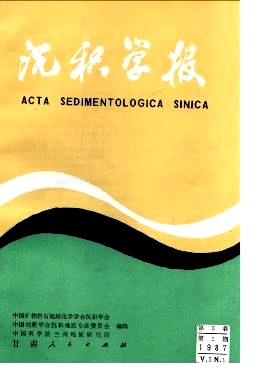X-RAY DIFFRACTION STUDIES OF KEROGEN
- Received Date: 1984-12-21
- Publish Date: 1987-03-10
Abstract: Kerogen structures of oil shales (Type Ⅰ, Ⅱ) sampling from Fushun, Maoming, Huangxian and lignite (Type Ⅲ) from Huanxian, and their artificial-thermal-degradation samples (the final thermal temperature is 375-510℃) have been investigated by using the X-ray diffaction technique (XRD). The XRD experimental curves were adjusted for polarization;normalized to electron units by fitting the adjusted curve to the independent scattering curve of carbon at the angle sin θ/A = 0.50;expressed in "reduced intensity" by substracting the incoherent scattering intensity of carbon and dividing by the independent coherent scattering intensity of carbon. The information extracted from the XRD structural parameters, such as intensity fractions (f), stacking height (Lc), peak position (sin9/A) of 002 and gamma band, indicates that the immature oil shale kerogen is constructed mainly by aliphatics, taking shape of a three dimentional netted and cage structure crosslinked by ring clusters and alkyl chains randomly, with bitumen trapped in the pores. The carbon aromaticity of an immature kerogen assessed by the XRD parameter f002 often gives a negative deviation with that measured by n. m. r. spectroscopy, it implies that part of aromatic rings may not be presented in the stacking structure of the aromatic clusters. The deviation is eliminated gradually as the maturity of the kerogen increases due to the progress of graphitization. Two XRD parameters, f001 and Lc, have shown their close relations both to the kerogen type and to maturity. Owing to the higher content of aromatic carbon and heteroatoms, the type Ⅲ kerogen gives higher f002 and lower Lc values than those of the type Ⅰ and Ⅱ with analogous maturity. A XRD diagram with f002 versus Lc of kerogens of different types and maturities can indicate the different evolution paths for different types of kerogen (Fig. 7), so it may be available to characterize kerogen as well as the H/C-O/C diagram which is commonly used.
| Citation: | Qin kuangzong, Zhang Xiuyi, Lao Yongxin. X-RAY DIFFRACTION STUDIES OF KEROGEN[J]. Acta Sedimentologica Sinica, 1987, 5(1): 26-36. |






 DownLoad:
DownLoad: